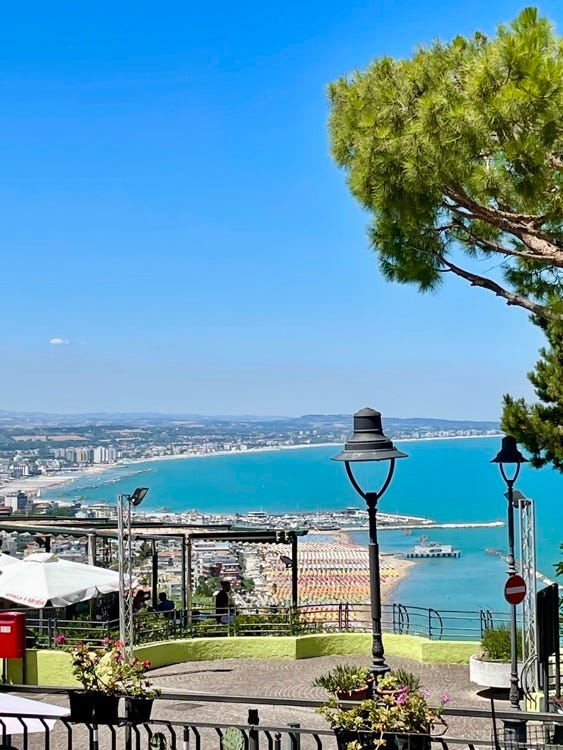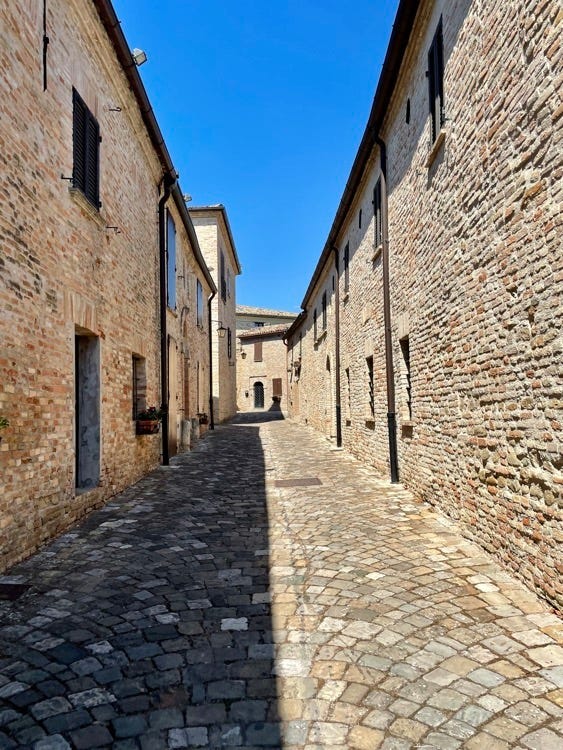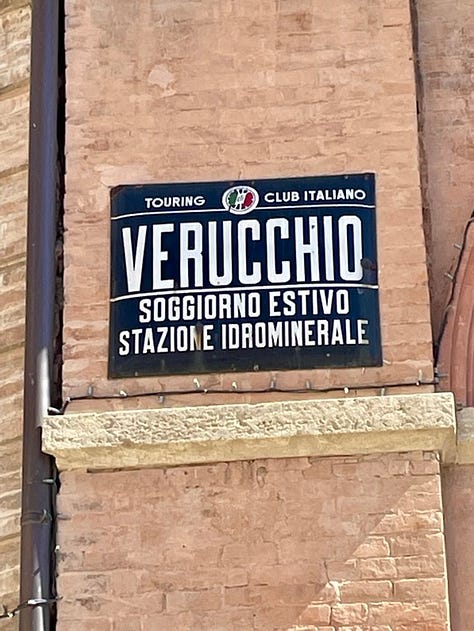Via Emilia: hamlets and castles of Romagna
An itinerary to discover Romagna and the Romagna Marche
Beyond the Riviera Romagnola, there is more. Above the hills of Rimini, Riccione, and Cattolica, there is a different Romagna. Today's newsletter is about the places where the Malatesta family, who ruled Rimini and Romagna during the Renaissance, has its origin.
Alt ✋
First, I need to say something: I love the Riviera Romagnola.
Here, you won't find the crystal clear sea water of Puglia or Sardinia or the elegance of Tuscany's Versilia. The Adriatic coast that looks at the Romagna is imperfect, national-popular, chaotic, with the sandy bottom and the sea water that looks murky, the lifeguard announcing beautiful weather even when the storm is sweeping the beach, the sound of cutlery bouncing in unison at lunchtime from the hotels between the pine trees and the hot asphalt, the smell of piadina that grabs your throat, the tourists dancing in the hotels on Sunday nights.
For me, the Romagna coast is not just a place. It is home.
Here, when I was a child I decided that I would not learn to swim, at least not seriously; I built sandcastles and indulged in the local beach snacks like bombolone or red pizza. The bombolone is a typical Emilia-Romagna recipe; even if similar, it is different from Krapfen.
Having declared my love for the Riviera Romagnola, I invite you to look up at the hills above Rimini-Riccione-Cattolica. Unlike the Forlì and Ravenna part of the coast, which has no hills but plains at the back, a gentle climb soon begins leading to medieval villages and castles that smell of piadina and strozzapreti pasta (the name literally means strangler the priest).
First, however, I would like to explain why I will mention municipalities outside the borders of Emilia-Romagna as if they were part of Romagna.
Are you familiar with the Romagna Marche area?
From the online Treccani Italian Encyclopedia:
【Romagna】is split between Emilia-Romagna, to which 7/10 of it belongs, Marche, which has 2/10 of it, and Tuscany, to which about 1/10 of it belongs (the so-called Romagna Toscana, until 1859 Romagna granducale). The Republic of San Marino is also in Romagna.
Treccani continues that other common elements include geological, geographical, climatic, and botanical aspects, as well as, of course, conditions of historical development and linguistic and gastronomic homogeneity.
In this newsletter, I mentioned Romagna Toscana, which is only an hour's drive from Bologna. Today, however, I would like to introduce you to medieval villages and castles in Romagna and Romagna Marche area. Yes, because piadina is a typical food from Romagna to Pesaro (Marche)! Even the accent, and not just the dialect, is Romagnolo.
Curiosity
In recent years, several municipalities in the province of Pesaro-Urbino (Marche) have chosen to come under the administration of Rimini via referendum. San Leo is one of the most famous villages in the Marecchia Valley that recently has chosen Emilia-Romagna.
There are (at least still) 12 municipalities in the province of Pesaro-Urbino that the physical geography includes in the territory of Romagna and that are part of the Marche: Auditore, Carpegna, Gabicce Mare, Gradara, Macerata Feltria, Mercatino Conca, Monte Cerignone, Montecopiolo, Monte Grimano Terme, Sassofeltrio, Tavoleto and finally Tavullia, the hometown of motorcycle champion Valentino Rossi (with his unmistakable accent Romagnolo).
That itinerary is ideal for a day trip, weekend, or vacation. The best time of the year to visit the Malatesta's hills is from spring to late fall. Even in midsummer, apart from Gradara, you will find few tourists.
Personal Note
This newsletter, which I love to write, takes me a lot of time.
Here, I make my skills and work available for free. Please don't take this commitment for granted and leave a public sign of your appreciation to support me and help others discover this space. Leave a comment and click on the heart you find at the bottom: these simple actions, which take you from a second to a minute (maybe), are important to me. Thank you! Monica
Villages, castles and strozzapreti pasta of Romagna
Cattolica, Gabicce Monte, Gradara


Cattolica is in Romagna while Gabicce and Gradara are across the border.
You can start from Cattolica and go up to Gradara or, on the contrary, start the trip from the top to the sea. The short distances allow you to visit these places in a day.
When in Cattolica, take a short walk along the Corso from the old village to the sea. A visit to the old food market is worthwhile. If you are moving in the middle of the tourist season, choose a smart time, for instance, early morning when the sea is shimmering, the air is fresh, and everyone is in the hotel has breakfast.
At Gabicce Monte, you must look out from its belvedere to admire the Adriatic Riviera of Romagna; choose a bright, sunny day to maximize the view. The spectacle of the Riviera dotted with the colors of beach umbrellas is a living postcard from the 1960s. Enjoy good food at Dalla Gioconda and Il Posillipo. If you have time, treat yourself to a swim at Vallugola (Gabicce mare/on the sea) and lunch at Falco.
Visit the marvelous Fortress of Gradara and walk along the fortified walls that still protect the village today. The Malatesta castle passed to the Sforza family not before the tragedy of Paolo (Malatesta) and Francesca (of Rimini) took place here in 1289. Dante Alighieri also mentions lovers in the Divine Comedy and, while feeling sorry for them, places the couple in the Inferno (hell). Needless to say, it is an evocative and romantic place. Lucrezia Borgia also lived in the castle for a brief period of her life.
I advise arriving early in the morning before the tourist wave.
Montefiore and Mondaino




Of the former, you will be amazed by the beauty of the imposing fortress overlooking the valley below. If you pass through in the late afternoon or evening, I recommend a stop at the village's Enoteca.
Mondaino is a fortified village where the ancient gate and walls are still visible. Although smaller, the circular square reminds me of the one in Senigallia. Walk down the short main street and visit Il Mulino della Porta di Sotto, where, by chance, the ancient pits of the Malatesta family were discovered. Since the Middle Ages, pits (fossa, fosse at the plural) were used to age cheese, called Formaggio di fossa, a typical Romagna product. In November, every year, the village celebrates the reopening of the pits.
Saludecio e Montegridolfo


Stop for a quick visit to the village of Saludecio and get ready for the wonder of Montegridolfo (the photo at right). The second one is the smallest and best preserved fortified hamlet of Romagna.
Sant'Arcangelo of Romagna, Verucchio and strozzapreti at Zanni in Villa Verucchio



Before heading up to Verucchio, stop in Sant'Arcangelo to visit the town. Come back at night to see it lively and lit up. Giving you advice on where to eat is difficult. So small is the city, and so long is the list. I say Oreste, Santabago (Cultural Enogastronomic Association), La Sangiovesa.
In Verucchio, there is one of the oldest Malatesta fortresses; the family's founder was born here. The fortress is small and pretty and offers an unmissable belvedere. From here, you dominate the whole landscape until the sea. The town is charming and one of my favorites among these; take some time to stroll along its streets and walk the castle walls.
Stop to eat at Zanni's, a historic restaurant with a butcher shop. The piadina, the wide, thin one typical of Rimini, arrives in the basket instead of bread. The strozzapreti with sausage and the barbecue are two highlights.
San Leo and the Republic of San Marino
If San Leo was a set for several movies, there must be a reason. Montefeltro, Della Rovere, and Malatesta fought over the territory, leaving medieval buildings and towers. The marvelous fortress housed like prisoner the Count of Cagliostro, born Giuseppe Balsamo, one of the Enlightenment's most controversial and enigmatic figures.
Stop in San Marino on your way back from San Leo. The small city is an independent Republic, like the Vatican City. It is worth a visit, out of season or when it is sunny and everyone else is at the beach.
Recipe from the blog: strozzapreti
Strozzapreti is a typical Romagna pasta made of water and flour. Did you ever taste it?
In the next weekly dispatch, you'll find several seasonal Italian recipes.
Let's keep the conversation going! Please write to me at tortellinico@gmail or follow me on Instagram.
If you enjoyed this newsletter, please click on the little ❤️ below ⬇️ and







I always look forward to reading your writings. They inspire one to travel and explore all that Italy has to offer. Thank you
Thank you Monica for this beautiful, interesting and informative tour. With your help, I have visited this charming area. I look forward to visiting it and discovering that, thanks to you, it is almost a return visit. See you soon!